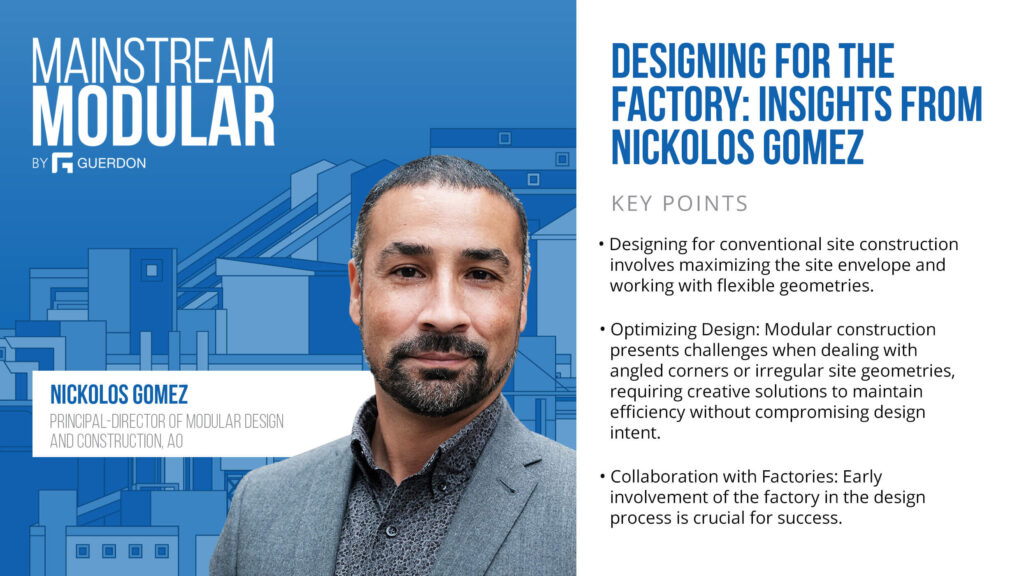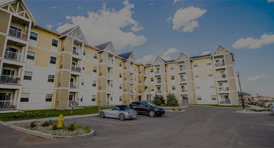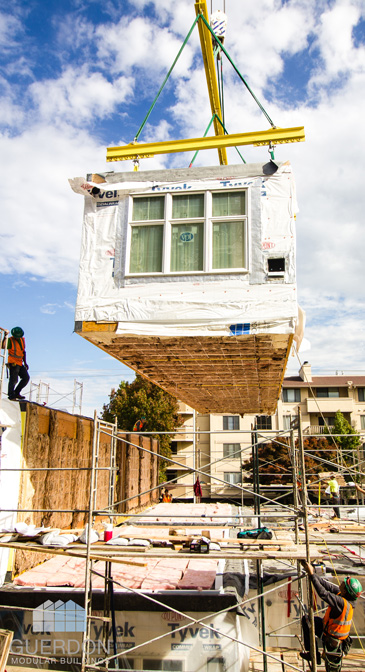
JUNE 7, 2023 – In an era of rapid urban development, the construction industry is on the precipice of a transformative shift towards modular construction. This episode examines why this transformation is taking place now, particularly in the light of labor shortages, rising construction costs, and a growing demand for sustainable building practices. Modular construction offers a viable solution to these challenges, offering speed, cost-efficiency, and minimized waste. According to a report from McKinsey & Company, modular construction can accelerate project timelines by 20% to 50% while reducing cost by up to 20 percent.
What does it take to effectively design for modular construction, and how does this differ from traditional on-site construction?
On the latest episode of Mainstream Modular hosted by Gabrielle Bejarano, she engages in a conversation with guest Nick Gomez, Principal-Director of Modular Design and Construction at AO. They discuss the nuances of designing for modular construction, the impact of factory involvement in the early design process, and tips for creating efficient modular designs.
Gomez highlights the unique challenges and strategies of modular design, such as the need to think in terms of components and the necessity of achieving design efficiencies. He emphasizes the importance of early collaboration with factories to ensure the design aligns with their production capabilities and constraints. He also shares real-life examples from his career, emphasizing the need for efficiency and repetition in modular design and the implications of not involving the factory early in the design process.
Guest Nick Gomez has been an influential figure in the field of architecture for the past 25 years, focusing predominantly on multifamily housing. He began his journey into modular design midway through his career, collaborating with various modular construction factories. His experience and depth of knowledge make him an industry expert, providing valuable insights into this evolving sector of architecture and construction.
 Mainstream Modular Spotify Podcast
Mainstream Modular Spotify Podcast  Mainstream Modular Apple Podcast
Mainstream Modular Apple Podcast
Designing For The Factory
Transcript:
Gabrielle: Hello, everyone and welcome to another episode of Mainstream Modular brought to you by Guerdon! I’ll be your host for today, Gabrielle. And right now, I’m so thrilled to be joined by Nickolos Gomez and he’s actually Principal Director of Modular Design and Construction. Today we’re going to be talking about designing for the factory in specific. So, here to enlighten us on the subject as well as provide any and all actionable industry insights is Nickolos. So Nickolos, welcome.
Nickolos: Thanks for having me.
Gabrielle: Absolutely. So to start off, just tell us how you got into Modular. Give us a little bit of your bio so we give our audience a better idea of just some of your previous experience, what you’re working on right now, and just how your biography lends itself to the discussion that we’re about to have.
Nickolos: Yeah, sure. So I started in architecture about 25 years ago. I know I don’t look that old, but I am. I started doing multifamily housing, specifically affordable here in the Bay Area where I’m located. A little bit midway into my career, I started working with a factory up in Sacramento, which was called Theta. They have since gone out of business, but that was my first introduction to Modular. And once you sort of dip your toe into that field, it’s such a small field, you become an expert right away. So that led to working with Guerdon, who I’m doing podcasts today with, and I completed several projects with them. And after you work with Guerdon, you start working with Nashua and Factory_OS and CNC out of China. So I’ve been really fortunate to grow and work with most people in the industry. And I really enjoy working with everyone. It’s a very collaborative effort and both the site GCs and all the factories involved and the clients.
Gabrielle: All right. So Nickolos, just what are some of the main differences when it comes to design for a conventional site construction versus modular offsite construction? Could you give us a few of those differences?
Nickolos: So when you’re designing for a site, you really are not constrained by the geometries of the modular box. So you have to kind of think about your design and building out of components versus just maximizing the site envelope, which is what most site projects do. You sort of take your setbacks and you make your building from there. But in modular, you’re really having to think about how do you construct a building out of the rectangular boxes. And so there are design tips that you sort of pick up along the way to do that. One of the other things that I kind of have to explain to our designers right away is that we are not just making the building for the module, but we also have to think about efficiencies. We’re not only lining the building up horizontally, but also vertically. And then we also want to maximize components. If you can keep the same master in all the units, that’s good for the factory because you want the factory to build one thing a hundred times versus a hundred things once, which you do on site. So it’s always about efficiencies and looking at how those components that the factory is going to build form a building in the end.
Gabrielle: Yeah, there’s quite a bit that goes into factory production. So how do you find ways that you can optimize design?
Nickolos: It’s trying to come up with the most efficient layouts is kind of what you’re doing in the end. So if you’re repeating your kitchen and bathroom cores in your studio and your one bedroom units, or your one bedroom units maybe have the same core as a two bedroom, you’re just adding an extra module to then create that second bedroom. And lining things up across the corridor, like your stairs and your vertical circulation, just how those cores work out. In a site project, for instance, if you’re doing an inside corner L, the most common thing that people do is a diagonal wall from that exterior wall to the corridor, and you have two units in that interior corner. You can’t do that with modular. There’s no angles in modular. And same thing with say site irregular geometry, if you have sort of an angle on one side of the building, you can easily respond to that in a site project. But with modular, you’re going to either have to step it, or you’re going to have to figure out a way to get an angle to occur in that building. So there’s just different tips and tricks that you kind of have to do in order to kind of make the modular probably deficient. Because what you don’t want to do is you don’t want to force modular on something and you’re eroding the efficiency of it, right? The factory is going to have problems building it. The site installation is going to take longer, right? So avoid all that. Let’s just start with the most efficient thing in the beginning, and let’s just make sure it’s appropriate for the factory to build.
Gabrielle: Well factories should give you feedback, I’m sure. So what kind of input do you get from factories earlier in the design process?
Nickolos: Yeah, so that’s what I’d like to tell clients early on is, we should have a team ideally in place before we start the project, or as we mobilize the project. And that’s because I do like to get input from the factory. My team, we’re the architects, right? We make the building. We’re not necessarily on the factory floor and thinking about production. So as soon as we do that layout, we want to get it in front of the factory. Because all factories are different. Some factories have 74 foot long boxes, some do 72, some might do 70. And it’s based on their footprint in the factory. So if I don’t know what factory I’m designing for, I’m going to have to design to the least common denominator, right? So I may be leaving things on the table. So if we know where the factory is, we can show them our floor plans up front. They can give us input. Maybe we need to reduce the width or length of a certain box so that when we’re doing sawboxing, it fits better. So those are all great things to get the input from the factory right away, because we want the plans to be the most efficient for them to build in the end. And sometimes there’s negotiation too. Sometimes there may be things that they say, well, this maybe isn’t really going to work out for us. But if it’s an important element of the building, then we can do the collaboration to figure out how we can achieve that design element. And that’s what’s great about working with factories early on, is that you’re able to get in there and do some back and forth to kind of achieve in the end what you want for the project and what’s best for them to build.
Gabrielle: No, absolutely. And that’s everything that comes when you start that communication process early with the factories. But on the other hand, what are some of maybe the impacts that happen or can happen if you don’t have that option and you don’t get the factory on board earlier?
Nickolos: Yeah. So as I kind of alluded to earlier, it’s you’re designing one for the base common denominator. And then so what that means is when a factory does come on board, there’s going to be some rework to the plans, because you didn’t really understand the responsibility scope matrix. The factory wasn’t telling you what they’re going to build and finish in the factory and what was going to be site. So you’re not really making the project maybe as efficient as you could in the beginning. And then if you’re having to bring a factory on board later, the redesign works. So that means the factory is giving you late input, and then they’re going to shuffle some things around and you’re going to have to go back and adjust the plans to fit the factory. And the clients, when I mentioned that to them, they might be like, well, you know modular, how are you going to have to rework later on? Well, it’s because factory production is specific to the factory. They’re going to give me the input that’s best for them and their production line. As I mentioned, I design buildings, but I don’t do the factory production in the factory. The factory controls that. So there may be little things that they want to change so that it’s more efficient for them to build. And those are the things we want to do because the efficiencies keep the cost down and it gets production up.
Gabrielle: Well, Nickolos, any last bits of advice to our audience in terms of what to keep in mind when you’re designing for the factory?
Nickolos: When you’re designing for the factory, just efficiency is, I say that word over and over again. Being efficient with your plans is important. Repetition is important. When you are doing things that are anomalies, just make sure you get in front of the factory, get some eyes on it, get some input. Yeah, if the factory is not on board early, you may be forcing the factory to do things that are slightly inefficient. And one of the projects that I worked on with Guerdon that I could kind of point to would be like the South Second Street Studios. That project was entitled early and the owner decided to go modular. And in order to make the plan work, we had to rotate the models sideways to the core board. And it worked for factory production, but in the end, it was kind of inefficient for site work. And so being able to have that collaboration early on, having the factory and the site GC and the architect and the engineers working through all the design and movement, I think is a lot… It makes the project a lot better in the end. And that’s what we want for factory production.
Gabrielle: Well, that wraps up the conversation for today. So thank you, Nickolos, for joining us on today’s episode to discuss designing for the factory on mainstream modular. Thanks for joining us. Well, as always, if you’d like to learn more, please visit guerdonmodularbuildings.com and look for this podcast wherever it is you get your podcasts at. I’ve been your host, Gabrielle. Thanks for tuning in.
About Guerdon
Guerdon is the leading manufacturer of large-scale, commercial modular construction projects in the Western US and Canada. Guerdon’s modern, innovative modular technology combines on-site construction with precise off-site factory assembly line production. Traditional schedules are shortened substantially because modular units are constructed in our factory-controlled environment while site work and foundation construction are completed concurrently. Guerdon helps developers, architects and general contractors gain greater control over project quality, schedule, and the bottom line. Guerdon’s factory and corporate office are in Boise, Idaho serving 12 western states including California, Colorado, Idaho, Montana, Nevada, North Dakota, South Dakota, Oregon, Utah, Washington, Arizona and Wyoming as well as Canada.








